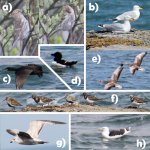Hello
I am not sure whether this is the done thing, but it seemed easier than posting lots of new threads. Basically I am pretty new to birding, and very new to sea birds! The images attached were all taken on Anglesey last week. I think I know some, but others I am not so sure about.
a) ???
b) Herring Gull?
c) Double Crested Cormorant?
d) Razorbill?
e) Greylag Goose?
f) They were all part of a large group that were swarming very close to the water. I guess the one on the right with the white head is a young Plover of some type? But is the smaller one with the longer beak and black breast a Dunlin?
g) ???
h) Great or Lesser? Black Backed Gull
Thank you very much for any help with these.
I am not sure whether this is the done thing, but it seemed easier than posting lots of new threads. Basically I am pretty new to birding, and very new to sea birds! The images attached were all taken on Anglesey last week. I think I know some, but others I am not so sure about.
a) ???
b) Herring Gull?
c) Double Crested Cormorant?
d) Razorbill?
e) Greylag Goose?
f) They were all part of a large group that were swarming very close to the water. I guess the one on the right with the white head is a young Plover of some type? But is the smaller one with the longer beak and black breast a Dunlin?
g) ???
h) Great or Lesser? Black Backed Gull
Thank you very much for any help with these.





